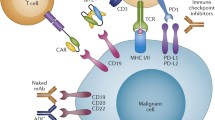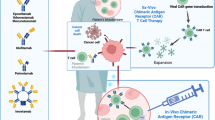Abstract
We report two preliminary trials of antibody treatment of B-cell lymphoma. Advanced lymphoma was treated with chimeric FabFc2, in which mouse Fab'γ is linked to two human Fcγ1 fragments so as to recruit natural effectors to tumor targets. Terminal lymphoma was treated with bispecific antibody (BsAb) which recruits the ribosome-inactivating protein saporin. These different mechanisms led to interesting differences in patterns of tumor clearance.
Eight patients were treated with chimeric antibody of two specificities, each at 12 mg/kg: anti-CD37, plus either anti-CD38 or anti-CD19 according to tumor phenotype. On completion of the 3-wk treatment, residual plasma antibody had a half-life exceeding 10 d. Tumor cells in blood disappeared rapidly. However significant reductions in solid masses occurred in only three patients, becoming apparent 3–4 wk after beginning treatment and then continuing slowly.
Five patients were treated with preformed immune complexes of saporin and F(ab'γ)2 BsAb. Although doses of saporin reached 10 mg weekly, contact with the tumor can only have been fleeting: plasma antibody was undetectable (<0.5 μg/mL) 48 h after infusion, whereas the saporin disappeared even faster and was undetectable (<4 ng/mL) at 24 h. Tumor cells disappeared from the blood more slowly than occurred with chimeric antibody. In contrast shrinkage of extravascular tumor was more rapid, and occurred in all patients, but proved less durable.
Similar content being viewed by others
References
Grossbard, M. L., Press, O. W., Appelbaum, F. R., Bernstein, I. D., and Nadler, I. M. (1992)Blood 84, 863.
Stevenson, G. T., Glennie, M. J., and Kan, K. S. (1993) inProtein Engineering of Antibody Molecules for Prophylactic and Therapeutic Applications in Man. (Clark, M. R., ed.), Academic, Nottingham, UK, in press.
Glennie, M. J., Brennand, D. M., Bryden, F., McBride, H. M., Stirpe, F., Worth, A. T., et al. (1988),J. Immunol. 141, 3662.
Stirpe, F., Gasperi-Campani, A., Barbieri, L., Falasca, A., Abbondanza, A., and Stevens, W. A. (1983)Biochem. J. 216, 617.
Bonardi, M. A., Bell, A., French, R. R., Gromo, G., Hamblin, T., Modena, D., et al. (1992)Int. J. Cancer Suppl. 7, 73.
Meeker, T. C., Lowder, J., Maloney, D. G., Miller, R. A., Thielemans, K., Warnke, R., et al. (1985)Blood 65, 1349.
Lanier, L. L., Babcock, G. F., Raybourne, R. B., Arnold, L. W., Warner, N. L., and Haughton, G. (1980),J. Immunol. 125, 1730.
Stevenson, G. T. and Glennie, M. J. (1985)Cancer Surveys 4, 213.
Vitetta, E. S., Stone, M., Amlot, P., Fay, J., May, R., Till, M., et al. (1991).Cancer Res. 51, 4052.
Spiegelberg, H. L. (1974),Adv. Immunol. 19, 259.
Author information
Authors and Affiliations
Rights and permissions
About this article
Cite this article
Stevenson, G.T., Bell, A.J., Evans, T.R.J. et al. Mechanisms in removal of tumor by antibody. Cell Biophysics 24, 45–50 (1994). https://doi.org/10.1007/BF02789214
Issue Date:
DOI: https://doi.org/10.1007/BF02789214




